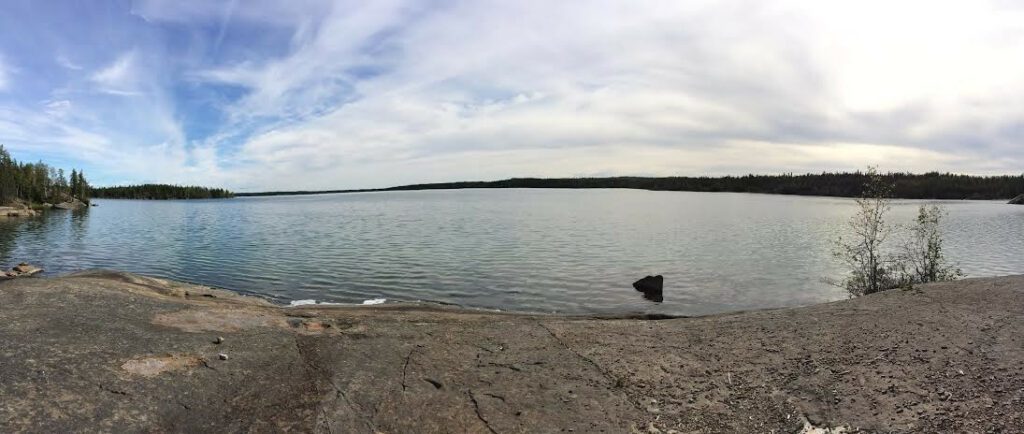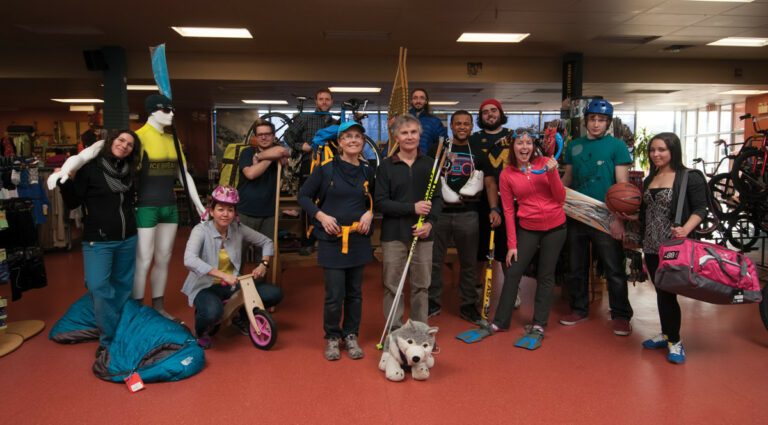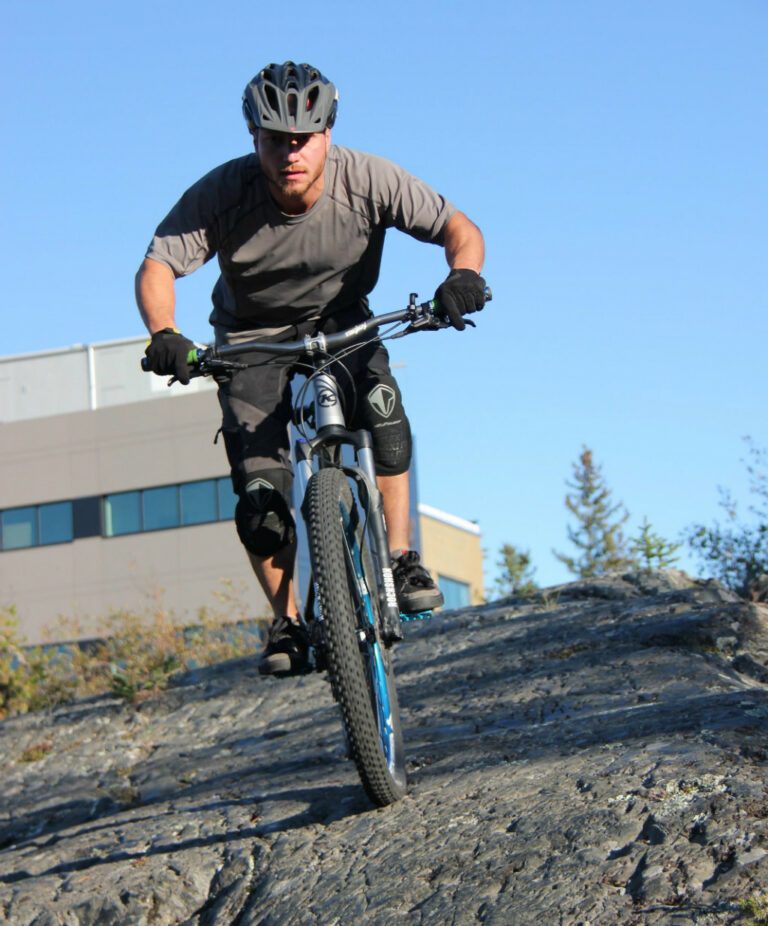It was about an hour-and-a-half hike out after I stepped down from a rock on the way out from Big Hill lake and snapped my right ankle to the point of – as an x-ray later showed – the ligament tearing off a piece of the bone.
I like to think I have strong ligaments.
I was with my sister and a friend, neither of whom were in any position (read: strong enough) to carry me out. So, I opted for using a sturdy stick as a cane and wrapping my sports bra around the quickly swelling ankle to maintain pressure. I’d heard somewhere that applying pressure is important.
Actually, I’ve taken First Aid before and was at one time the safety officer for a bush camp – I should probably have had a better idea of how to deal with situations like this. But a sports bra/tensor bandage and stick was the best I could come up with in the moment.
We weren’t exactly stranded. We had cell reception and a few friends were just a bit behind us on the trail. An unknown runner actually came upon us as I was writhing on the ground in pain, claiming that I might vomit at any moment – I didn’t.
He offered to help in any way he could, but there wasn’t much he could do save fireman-carrying me off the trail, and I wasn’t quite ready to ask for that sort of favour. I have yet to run into that person again since this incident back in last August – which is surprising for Yellowknife – but if he reads this, I assure you I am a more stable person than I appeared at the time. Both physically and emotionally, that is.
Surviving it better
But all of this leads to a question: what should I have done?
Was hobbling out with a makeshift cane and bumming my way down rock elevations the right thing to do? Should I have called the RCMP to heroically appear and airlift – or quad ride – me out of there?
Would removing the added trauma of putting weight on my foot immediately after the break have saved me from realizing my middle toe was turning purple just before walking down the aisle at my sister’s wedding? Maybe not, but I do have recurring mysterious pain in that foot every now and then – and not only during that one time this year that I wore heels.
With the sun out and the weather heating up, the trails are getting beaten down again. Maybe someone else, God forbid, will have the unfortunate experience of one part of your body ripping off another part of your body – or any other injury that leaves you pretty-well incapable of comfortable mobility.
So EDGE spoke to a few experts to get a rundown of what do to keep a minor injury from becoming a full-blown emergency.
And, just to clear up how frequently these injuries occur: both sources EDGE spoke to had their own tales of bumps, bruises and breaks on the trails. Both also happened at Big Hill, but let’s not go blaming one of my favourite hikes in the area.
“When you’re first getting into Big Hill Lake, you go up a couple of sections that are a bit rocky and steep,” says Tom Girroir, head of Yellowknife Search and Rescue. “I was coming down one of those rocks – it wasn’t too high, 3.5 feet high maybe – but it was rainy and I was in a hurry and not paying attention. I slipped, landing on my elbow and dislocated my shoulder.”
Six months later, Girroir was still rehabbing the shoulder, but at the time he was lucky to be able to immobilize it and make his way out.
In his decade with Search and Rescue, Girroir says they’ve never received a call for a rescue – just searches. They’ve yet to haul an injured hiker out of the bush.
So, in terms of calling for help, he says the RCMP would be your initial point of contact and they would then reach out to Search and Rescue, if necessary. That said, when you’re on a trail and not accessible by road, emergency response is limited, so if possible, you want to get to the closest road.
“You don’t have a whole lot of options when you’re out there,” Girroir warns.
Just recently, medevac capabilities were expanded to touch on all parts of the territory, says Julie Downes, a field instructor with Arctic Response.
But it will cost you.
She estimates just getting a helicopter off the ground might ding you around $500, with that price increasing depending on the distance of the flight. So, when should you make that call (assuming cell service is available)?
If someone is in danger of essentially dying due to their condition, in the next 10 minutes or so, Downes says, clearly, you should make that call. As well, if there’s a chance they could lose a limb due to the injury, there could be permanent damage to an eye or if circulation to an appendage is cut off.
Just a few weeks back, Downes had just made it in as far as Big Hill Lake when she slipped on mud, crash-landing on her knee.
“I limped out but when I hit my knee, initially it was one of those moments where I’m like, ‘Am I hurt or am I injured?’” she says.
“I cut my leg up through my pants by hitting the rock so hard, but it was good that it was stable and I could put weight on it.”
She offers a few tips on discerning a minor injury from a major one:
- One big thing is, is it stable or unstable? Can that person put weight on the affected area or is it excruciatingly painful?
- Do you see a massive amount of visible deformity?
- If the arm or leg is injured, check the capillary refill. Push down on the fingernail or toenail until it turns white and release that pressure. If it goes back to red in five seconds, that’s good capillary refill. If the appendage is getting cold, pale and clammy or has a blue tinge and there’s long capillary refill that means blood is not flowing anymore and they need to get to the hospital ASAP.
And, when the assessment is done, don’t forget to RICE:
- Rest and reassure
- Ice or put something cold on the affected area for 10 minutes on, 10 minutes off
- Compression, like a tensor bandage – or sports bra?– that can provide ease and compression throughout the wound site, doing the job of tendons and ligaments in holding it all together
- Elevate to reduce swelling and recovery time
Mitigating the risk
Is there a definitive way to prevent injuries when hiking? Well, you could stay home. But for everyone else, there are a few ways to mitigate risks ahead of time.
One of the biggest tips Girroir emphasizes is having a plan, sticking to that plan and making sure someone in town knows about it. Tell that person where you’re going, when you’re going and roughly when you’ll return. And clearly communicate what they should do if you don’t make it back by the expected time.
“If you leave and the plan is to be out by 3 p.m., tell your friend that you leave the plan with, if you’re not out by 3 p.m., send someone to check if the vehicle is still (at the trailhead),” he says. “If the vehicle’s still there, we’ve got problem. At which point tell them to call the RCMP.”
When packing your bag to head out on the trail, Downes says to keep the five priorities for survival in mind.
“Everyone is always asking, what do you put in your survival kit?” Downes says.
“But it always depends. If I’m going out on the tundra in January, my survival kit is the size of a large duffel bag. Obviously, someone hiking Big Hill for the day can’t expect the same thing. As long as you support your ability to accomplish your five priorities, that’s your survival kit.”
Priority 1: First Aid
Think about the most common injuries related to what you’re doing. On a hike, always bring a tensor bandage and something to get bleeding under control. If you have an existing injury, like to a knee or ankle, bring your brace, as the likelihood of re-injuring is higher.
Priority 2: Signaling
Depending on where you’re going, you may or may not get cell phone reception. Either way, you’ll want a way of signaling others to make your location known and alert them.
“It sounds dorky, but I always have a whistle and I can grab it with my mouth if I need to,” Downes says. “It’s on the side strap of my backpack, it’s not cumbersome at all. People often bring a whistle but bury it in their backpack. If you do injure yourself, you want to reach it in a hurry, not dig through your bag.”
Bring a whistle, allowing you to alert others to your location and keep it close by, like on the strap of your backpack, so it’s always accessible .
Heading out farther on the land? A SAT phone is certainly advisable.
Priority 3: Shelter
You want to think about the least amount of things to carry that will still allow you to build a decent lean-to if stuck out in that environment.
A hatchet or a machete are great, but something like a Speedy Saw is extremely light and packable and allows you take trees down for a lean-to. And don’t forget rope – lashing is going to be your best friend.
Lastly, the clothes you’re wearing are also shelter. For hiking, a tank top and shorts is fine because you’re moving and burning calories. If you fall and break an ankle, you’ll get cold pretty quickly and will want extra layers for warmth in case you’re hunkered down for a while.
Priority 4: Fire
Bring a small box of Redbird matches, double wrapped in Ziploc bags. Waterproof matches are great because they’re waterproof but you’ll go through six to get one lit as they break easily.
“Fire has so many benefits – physiological, warmth, predator defense, boiling water,” Downes says. “I’d be pretty pissed if I didn’t pack that one ounce box of matches.”
Priority 5: Water and food – but mostly water
Always bring a water bottle and a high calorie snack to fuel your body.
In a real survival situation, if you’re out of packed water, drink the water around you, because the side effects of things like giardia are going to kick in two weeks later. You may as well stay hydrated in an emergency and suffer the consequences later.
If it’s a standing pond, dig a hole next to the pond and allow water to filter through the edges or use a bandanna to filter larger chunks out.
“The dangers of dehydration are real and now,” Downes says.
So, with a little help from my hiking companions – actually a lot of help; they traded off acting as human crutches on the rougher terrain, drove my car back into town and made the run in to the store for heavy painkillers – we made it out of the bush that day, with only minor consequences.
Did I do all the right things along the way? Well, after talking with the experts, I think that, aside from stepping so awkwardly off of a rock to break my ankle in the first place, I did the best I could with the cards I was dealt.






